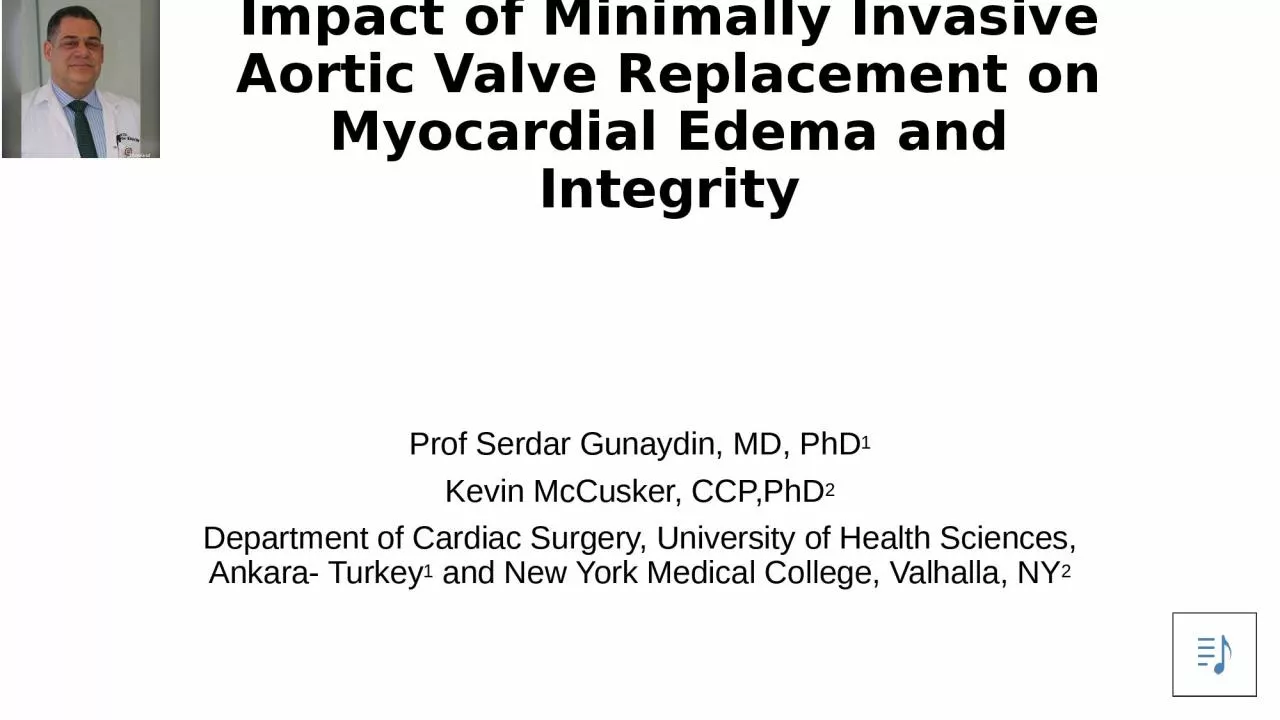

Prof Serdar Gunaydin MD PhD 1 Kevin McCusker CCPPhD 2 Department of Cardiac Surgery University of Health Sciences Ankara Turkey 1 and New York Medical College Valhalla NY ID: 932326
Download Presentation The PPT/PDF document "Impact of Minimally Invasive Aortic Valv..." is the property of its rightful owner. Permission is granted to download and print the materials on this web site for personal, non-commercial use only, and to display it on your personal computer provided you do not modify the materials and that you retain all copyright notices contained in the materials. By downloading content from our website, you accept the terms of this agreement.
Slide1
Impact of Minimally Invasive Aortic Valve Replacement on Myocardial Edema and Integrity
Prof Serdar Gunaydin, MD, PhD1Kevin McCusker, CCP,PhD2Department of Cardiac Surgery, University of Health Sciences, Ankara- Turkey1 and New York Medical College, Valhalla, NY2
Slide2DISCLOSURES
Project ConsultantLivanova Global,
Italy
Dr
F Köhler,
Bensheim, GermanyEssential Pharmaceuticals, NC, USAAdvancis Surgical, Nottinghamshire, UKHonorarium/TravelDr. Franz Köhler Chemie Essential Pharmaceuticals, NC, USACSL BehringLiva Nova, InternationalPfizer TurkeyVEM PharmaceuticalsAbdiibrahim Pharma, TurkeyInternational SocietyInternational Society for Minimally Invasive ECC, Executive MemberCREF- Cardithoracic Research & Education Foundation, USA , Board MemberHeart Team Education Foundation, President, Senior Scientific Board
Slide3NO CONFLICTS OF INTEREST
Slide4ANKARA CITY HOSPITAL CAMPUS
3804
hospital
beds
, 735 ICU Beds, 128 OR
Slide5BACKGROUNDEndothelial glycocalyx (EG) and aquaporines (AQP) are biomarkers of myocardial integrity and the transportation of fluid out of the expanded interstitial space into the capillary
Despite the popularity of single-dose cardioplegic techniques especially in minimally
invasive surgery
,
the
impact of hemodilution and time window for satisfactory protection especially in repeated doses still remain unclearThe present study aimed to compare plasma levels of syndecan-1, a biomarker of EG integrity and AQP levels in patients undergoing minimally invasive aortic valve surgery compared to conventional techniques
Slide6Microvascular Integrity- Glycocalyx
What is Glycocalyx?Glycocalyx
EG shedding is measured via syndecan-1 by ELISA with a solid-phase monoclonal BB4 antibody against an extracellular domain of human Syndecan-1
Slide7In
1992 , Aquaporins were discovered, proteins able to facilitate water
transport over
the
cell membrane at much higher rates than simple diffusion could explainThey called it CHIP, channel protein and this resulted in a Nobel prize during 2003´s ceremonyAquaporin channels do not use ATP for energy, only Ion channels need energyAquaporin channel only allow transport of uncharged particles via gradient pressure, making it
highly
effective
with
no
stored
energy
Water
will
move
from
high
to low concentration, facilitated both by Aquaporins and diffusion
Aquaporines
The expression of AQP was analyzed using quantitative real-time PCR
Slide8PATIENTS & METHODSThis prospective cohort study included patients undergoing aortic valve surgery between January 2017 and May 2019378 Patients were matched for age, gender, BMI and STS score: Group 1(MiAVR): Minimally Invasive Technique (N=102)Group 2 (control) (N=109)The approach was J sternotomy in Group 1 and full sternotomy in Group 2 with single dose cardioplegia (HTK) in both
The expression of AQP was analyzed using quantitative real-time PCREG via syndecan-1 by ELISA with a solid-phase monoclonal BB4 antibody against an extracellular domain of human Syndecan-1(coronary sinus samples before and after CPB)
Slide9EARLY CLINICAL OUTCOME
Slide10SYNDECAN-1 & AQP PCR
Slide11CONCLUSIONGiven its importance, protection of the EG and satisfactory AQP response are undoubtedly a promising future target in cardiac operationsSignificantly better outcome was demonstrated in MiAVR group via less transfusion, respiratory support and less ICU-hospital stay which might be a result of positive impact on molecular level protection
Slide12S Gunaydin, MD, PhDserdarkvc@gmail.com